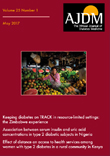Diabetes is associated with soft tissue pathophysiological fibroproliferative complications
*Corresponding Author:
Received: 30-Jan-2023, Manuscript No. AJDM-23-93127; Editor assigned: 01-Feb-2023, Pre QC No. AJDM-23-93127 (PQ); Reviewed: 15-Feb-2023, QC No. AJDM-23-93127 ; Revised: 20-Feb-2023, Manuscript No. AJDM-23-93127 (R); Published: 27-Feb-2023
Introduction
Diabetes mellitus is a chronic disease that imposes an enormous socioeconomic burden due to complications from various body systems. Life expectancy for people with diabetes is increasing due to the development of new anti-diabetic drugs and medical technologies. This means that the disease burden will also increase, reflecting the chronic complications of diabetes. Macro-vascular and micro-vascular complications directly threaten survival. Early detection, prevention and treatment of such complications are a priority. Although musculoskeletal disorders are epidemiologically recognized chronic complications, they have received less attention than life-threatening vascular complications. It remains unclear why diabetes is associated with soft tissue pathophysiological fibro-proliferative complications. A number of studies have found elevated levels of advanced glycation end products to be associated with micro-vascular complications of diabetes.
Description
Abnormal AGE accumulation can lead to fibro-proliferative complications. Proteins like collagen, which have low biological turnover rates, are particularly susceptible to glycation. It is clear that fibro-proliferative and micro-vascular complications are associated. The latter must be inspected if the former is present. As with other diabetic complications, tight glycemic control may prevent the development and slow progression of such complications, but it cannot be fully reversed.
There is no treatment that can reverse the progression of the disease. Early conservative treatment aims to control pain and limitation of movement. If there is no response and irreversible malformations develop, surgery is possible. Limited Joint Mobility Syndrome (LJMS) is characterized by limited mobility of small hand and finger joints. Symptoms include painless stiffness, fixed flexion contractures, limited fine movement, and decreased grip strength (both hands and fingers). Before restriction, the skin on the back of the hand may be thick and waxy. Useful clinical features include prayer signs and table signs. The prayer sign is present when the entire surface of the hand cannot be pushed down when the palm and fingers touch the wrist during dorsiflexion.
The table-top sign is positive if the surface of the palm is not completely touching the table, but away if the palm is touching the table-top at right angles. Diseases such as osteoarthritis, rheumatoid arthritis, scleroderma, and systemic lupus erythematosus should be excluded. LJMS can also occur in joints other than fingers. For example, his LJMS in small ankles may increase the risk of falls and diabetic foot ulcers. In some cases, surgery may be required. Constrictive tenosynovitis (commonly called trigger finger) is caused by inflammation resulting from repeated friction between the flexor tendon and the tunneling sheath that provides mechanical stability to the tendon. This causes the tendons and tendon sheaths to swell and form knots.
Conclusion
The flexor tendon is pinched in the tunnel and the finger joint is fixed in flexion. Dupuytren’s Contracture (DC) is a progressive condition in which nodules or contractures of the palmar fascia are formed caused by fibrosis. Intralesional clostridial collagenase injection relieves contracture and improves joint motion. Surgery may be considered if progressive flexion contractures impair joint motion. Recurrence after surgery is more common in diabetic patients. Neuropathic arthropathy, also known as charcot’s arthropathy, is a progressive and destructive disease of joints and adjacent bony structures caused by loss of sensation.
Acknowledgement
None.
Conflict of Interest
The author has nothing to disclose and also state no conflict of interest in the submission of this manuscript.





